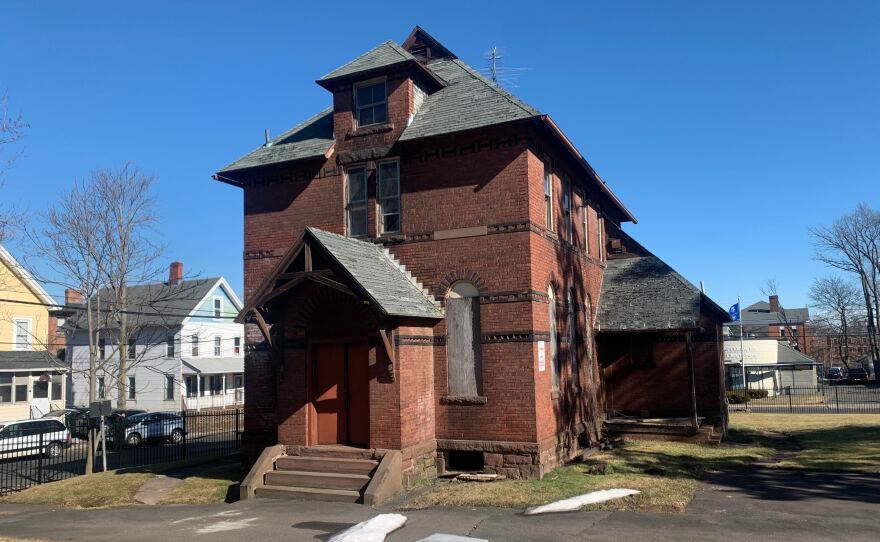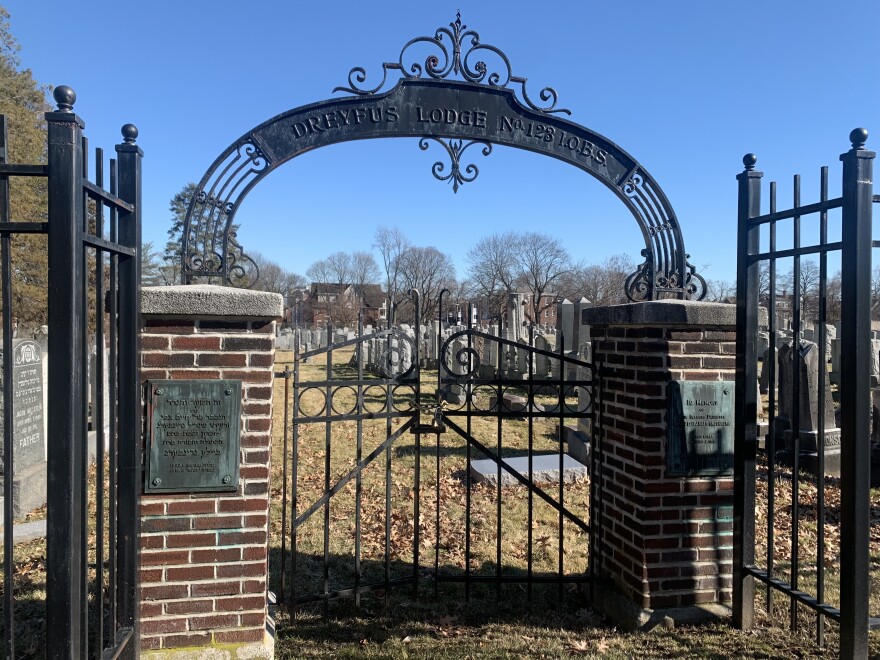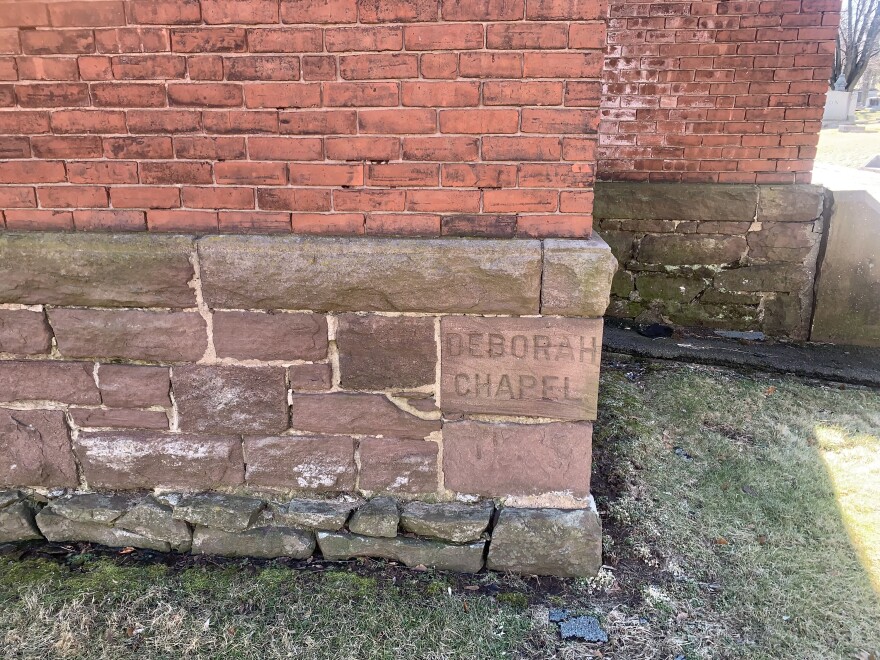Residents and city try to save historic Hartford chapel threatened with demolition

Congregation Beth Israel wants to demolish the Deborah chapel, a historic Jewish chapel at the corner of Ward and Affleck St. in Hartford, Conn. (Nirvani Williams / NEPM)
At the edge of a Jewish cemetery in Hartford, Conn., is a three-story, red-brick building strewn with vines. It’s known as the Deborah chapel. Built in 1886, it used to be a mortuary where the deceased were prepared for burial according to Jewish custom.
Congregation Beth Israel owns this part of the cemetery and the chapel in Hartford’s Frog Hollow neighborhood. But they want the building demolished.
Frog Hollow resident Carey Shea wants to save it.
“This is the only mortuary building in this neighborhood. And what makes it really special is that it’s a Jewish mortuary built by women,” Shea said.
Shea worked in community development before she moved to Frog Hollow to take care of her aging mom. After long days, she walks through the cemetery. It’s like a book with a thousand stories, she said, and feels particularly connected to one headstone.
“Raizel…Raizel says, ‘Otherwise, I’m fine,’” Shea read, laughing. “I Googled this woman and it turns out that she was a jewelry collector and collected jewelry that depicted death of all things. You can see from the stone someone’s come to visit her recently.”
Shea, who is not Jewish, is here with her friend, Susan Jaafar, who is.
“That’s a Jewish tradition. When you go to the cemetery, you leave a stone where you’re visiting, ” Jaafar said.

The closed gates to a historic Jewish chapel in Hartford, Connecticut, which is set to be demolished against the wishes of the city’s Historic Preservation Commission and some residents in the Frog Hollow neighborhood. (Nirvani Williams/ NEPM)
Congregation Beth Israel’s section is 5 acres and gated with a combination lock within the larger, 24-acre public Zion Hill Cemetery.
The congregation moved its synagogue to West Hartford in 1936.
The chapel attracted the attention of Samuel Gruber, an architectural historian at Syracuse University who specializes in the history of Jewish buildings. He said it’s rare that a chapel built before 1900 actually survived.
“This is built in the 1880s by Jewish women who are raising the money, who are administering the project. And this is at a time when women in America, Jewish women and Christian women had no rights,” Gruber said. “I think that this is a building that’s just loaded with the opportunity for learning more and teaching more. It’s sort of a doorway into that past.”
Frog Hollow neighborhood home to large Latino population
The congregation’s leadership said one of the reasons they want to tear down the chapel is because they believe it’s in an unsafe neighborhood.
“What we’re trying to do is to take away the house that the dealers and addicts have moved into,” Sandra Bernstein, now the president of Congregation Beth Israel, told the Hartford Historic Preservation Commission in April 2019.
Bernstein asked for a demolition permit because members of the congregation “want their cemetery back.”
“I can’t imagine living in that neighborhood and having children. I see children on bikes. Why were they there, are they going to get drugs? Is it — I just can’t imagine,” Bernstein said.
Bernstein said she and Gary Jacobson, the former president of Congregation Beth Israel, have made attempts to clean the property.
“Gary and I were down there for two hours picking up needles off of graves, so that’s what brings us here today, not just a whim,” Bernstein told the commission.
Reinaldo Rojas, a professor at Central Connecticut State University, wrote his dissertation on socioeconomic disparities in Frog Hollow.
“To paintbrush it with this issue of drug addiction and needles and even attacking children or attacking the parents who decide to live there — listen, nobody wants to live in poverty,” Rojas said.
Recent Census data shows that 73% of the Frog Hollow neighborhood is Hispanic or Latino.
“It’s (a) very racist, very damaging attitude to attack the residents of the neighborhood for the problems that they have, which are problems that are bigger than they are,” Rojas said. “Problems of marginalization, seclusion and segregation … segregate these communities in these poor neighborhoods. So it’s just tiring to see that.”

A cornerstone of the Deborah Chapel, a historic Jewish chapel in Hartford, Conn. (Nirvani Williams/ NEPM)
Members of the historic commission also took issue with Bernstein’s characterization of Frog Hollow. Commission members said those problems would continue even if the building was removed.
They offered alternatives to demolition, like lifting deed restrictions, so the chapel could be remodeled for private or public use.
That still didn’t change Congregation Beth Israel’s mind.
The debate landed in court
The congregation declined our request for an interview, but sent a statement saying that “for the sake of safety of those visiting the cemetery, we plan to demolish the building and replace it with a contemplative place.”
Hartford’s historic commission ended up denying the request for a demolition permit, but the congregation took it to court.
After a trial last March, the congregation won. Judge Thomas Moukawsher wrote in his order that in addition to the chapel being in a “troubled neighborhood,” it’s not “economically feasible” to renovate the building.
Shea, who has since joined the historic commission, said that after the court case, she offered to buy the chapel for $75,000, renovate and live in it to help maintain the building.
“I had an attorney actually approach them on that and he approached them twice,” she said. “And they seem to not like the idea.”
The city of Hartford filed an appeal to the court’s ruling to block the demolition. A response by Congregation Beth Israel is due by the end of the month.
